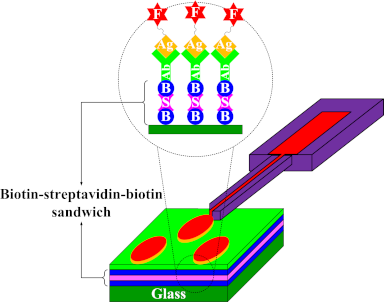
Evaluation of click chemistry microarrays for immunosensing of alpha-fetoprotein (AFP)
-
Author:
S. M. M. Dadfar, S. Sekula-Neuner, V. Trouillet, H.-Y. Liu, R. Kumar, A. K. Powell, M. Hirtz
-
Source:
Beilstein J. Nanotechnol. 10 (2019) 2505–2515
- Date: 2019
-
The level of cancer biomarkers in cells, tissues or body fluids can be used for the prediction of the presence of cancer or can even indicate the stage of the disease. Alpha-fetoprotein (AFP) is the most commonly used biomarker for early screening and diagnosis of hepatocellular carcinoma (HCC). Here, a combination of three techniques (click chemistry, the biotin–streptavidin–biotin sandwich strategy and the use of antigen–antibody interactions) were combined to implement a sensitive fluorescent immunosensor for AFP detection. Three types of functionalized glasses (dibenzocyclooctyne- (DBCO-), thiol- and epoxy-terminated surfaces) were biotinylated by employing the respective adequate click chemistry counterparts (biotin–thiol or biotin–azide for the first class, biotin–maleimide or biotin–DBCO for the second class and biotin–amine or biotin–thiol for the third class). The anti-AFP antibody was immobilized on the surfaces via a biotin–streptavidin–biotin sandwich technique. To evaluate the sensing performance of the differently prepared surfaces, fluorescently labeled AFP was spotted onto them via microchannel cantilever spotting (µCS). Based on the fluorescence measurements, the optimal microarray design was found and its sensitivity was determined.
